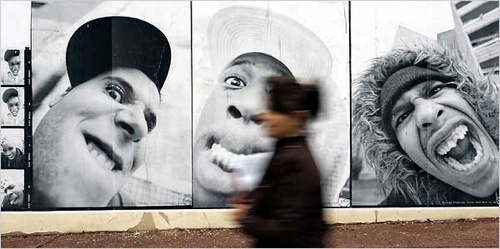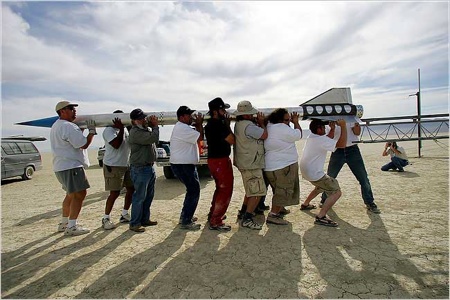Notes
Your Turn: The Tension Of Clichy-sous-Bois
Yesterday, the NYT featured this image with an article on the upcoming one year anniversary of suburban rioting in France. The picture, in fact, led the on-line edition.
The gist of the article was that, nearly a year after the controversial death of two immigrant boys in the suburb of Clichy-sous-Bois, the French have done little to aid those warehoused in the slums, and that tensions (in part, spawned by the anniversary) are again on the rise. (If you remember, last year’s rioting was touched off by the allegation that the boys, who were accidentally electrocuted, had been running from the police.)
The image is intended to highlight government inattention. It derives from an exhibition in Clichy-sous-Bois to raise awareness, and put a face on those who have been exiled by race and religion. According to the article, last week’s opening drew the participation and attendance of leading photographers from around the world. Despite the “buzz,” however, not one French official (beyond the local mayor) showed up.
As exhibition images, especially in Clichy-sous-Bois itself, these pictures seem extremely powerful. They shout out desperation, anguish, and an urgency to be recognized. At the same time, they viscerally convey how much these young men perceive themselves (and sense themselves, through the gaze of society) as animals, deviants, monsters, freaks.
Here’s where I have the question, though.
This image led the NYT on-line edition. (Granted, the paper also provided this objective caption: “A photo exhibit of young people tries to counter stereotypes in the Paris suburb of Clichy-sous-Bois, where riots broke out a year ago.”) Given the power of the image, however, and the fact a much smaller percentage of viewers would have clicked through to the article, to what extent does the picture lend appreciation of the problem, as opposed to dramatizing it, it or even exploiting these faces to sell news product?
Perhaps part of my discomfort has to to with the “anniversary angle.” Of course, the anniversary ritual is one of the most fundamental vehicles around which we construct meaning. It is also a staple in the creation of news. In the context of the story, however, how much is the image sacrificed in its social significance for a media “flash from the past,” not to mention its teaser value in the dramatization of rising tension and even the anticipation of more spilt blood?
And then, I was also wondering how much the foreground figure is complicit in the concern.
Portrayed as moving past in a blur, perhaps we, too, are prompted to gawk for a second, then do the same?
(If you click through to the article, I’m also interested in your opinion of the visual clash — and dialogue — with the other image, featuring those protest signs worn by members of the police union.)
(image 1: Christophe Ena/Associated Press. Clichy-sous-Bois. Published October 21, 2006. nyt.com. linked image: Dominique Faget/Agence France-Press. Paris. Published October 21, 2006. nyt.com)



Reactions
Comments Powered by Disqus